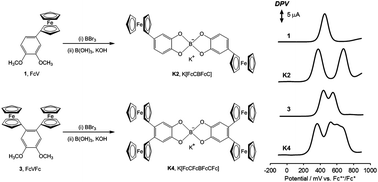Construction of di- and tetra-ferrocenyl spiroborate complexes from catechol building blocks and their redox behaviors†
Abstract
In this paper, we report a method for the construction of multi-ferrocenyl spiroborate assemblies from discrete mono- and di-ferrocenyl complexes. To prepare the building blocks for the spiroborate assemblies, 4-ferrocenylveratrole (1) and 4,5-diferrocenylveratrole (3) were first synthesized by Negishi cross-coupling between ferrocene and the corresponding aryl halides. Compounds 1 and 3 were characterized by NMR and UV-vis spectroscopies and electrochemical methods, namely cyclic voltammetry and differential pulse voltammetry. The potential splittings of 167 and 263 mV for the oxidations of the two ferrocenyl groups of 3 in CH2Cl2–n-Bu4NPF6 and n-Bu4NB(C6F5)4, together with the presence of an intervalence charge-transfer transition of 3+ in the NIR region, indicate a strong inter-ferrocenyl interaction through the ortho connection in the veratrole bridge. The treatment of 1 and 3 with BBr3, followed by complexation with B(OH)3 in the presence of KOH, afforded potassium salts of di- and tetra-ferrocenyl spiroborate assemblies, K2 and K4, respectively. The spiroborate assemblies K2 and K4 were characterized by NMR and UV-vis spectroscopies, ESI-MS, and electrochemical methods. K2 exhibited a potential splitting value of 302 mV in DMF–n-Bu4NPF6, indicating electronic interactions over the boron center. K4 exhibited four one-electron-oxidation waves in DMF–n-Bu4NPF6 and n-Bu4NB(C6F5)4; the one-electron-oxidized species 4 is thermodynamically more stable than 4+ and 42+. The overall E1/21–E1/24 spread for K4 is 201 mV larger than the E1/21–E1/22 splitting for 3 in DMF–n-Bu4NPF6, indicating that the spiroborate link between diferrocenyl units led to electronic interactions over the boron center.


 Please wait while we load your content...
Please wait while we load your content...